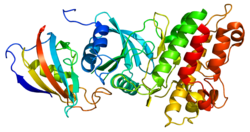Activin A receptor, type I (ACVR1) is a protein which in humans is encoded by the ACVR1 gene; it is also known as ALK-2 (activin receptor-like kinase-2). [5] ACVR1 has been linked to the 2q23-24 region of the genome. [6] This protein is important in the bone morphogenic protein (BMP) pathway that is responsible for the development and repair of the skeletal system. While knockout models with this gene are in progress, the ACVR1 gene has been connected to fibrodysplasia ossificans progressiva, an extremely rare progressive genetic disease characterized by heterotopic ossification of muscles, tendons, and ligaments. [7] It is a bone morphogenetic protein receptor, type 1.




